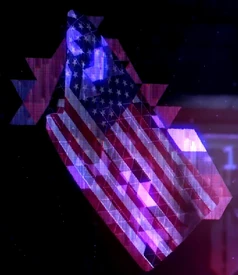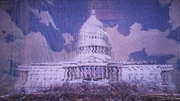
The flag of the United States of America
The United States of America, commonly known as the U.S.A, the U.S. and simply America, was an ancient country located on the North American continent. Like every other country in the world of the Old Ones, the United States was destroyed and its people exterminated when the Faro Plague overran the planet and eradicated all life.
The United States played a key role in both in the ending of the Old World and the creation of the new one. 6 of the 7 known tribes live in what was then known as Western United States.[1] Utah was the location of the robotics and technology corporation Faro Automated Solutions (FAS), which started what became the Faro Plague. The ruins of FAS are known in the new world as Maker's End.
The state was also the location of U.S. Robot Command, where the U.S. Joint Chiefs of Staff were briefed by the scientist Elisabet Sobeck on Project Zero Dawn, a plan to create a global terraforming system that would restore life to the planet after its eradication by the Faro Plague. The ruins of this facility are known in the new world as The Grave-Hoard. General Aaron Herres, Chairman of the U.S. Joint Chiefs of Staff, was responsible for devising and implementing Operation: Enduring Victory, a plan to give Zero Dawn as much time as possible to be implemented before life was eradicated. He also was responsible for procuring the world's most brilliant scientists and engineers as prospective candidates to work on Zero Dawn, and recorded a holographic presentation to the prospective candidates regarding the true nature of Enduring Victory and Zero Dawn.[2] Additionally, Zero Dawn's staging area was located at Bryce Canyon, in Utah. The ruins of this facility now sit beneath Sunfall, former stronghold of the Shadow Carja.
Finally, Bashar Mati, an FAS employee, planted several time capsules known as Vantage Points throughout Colorado and Utah, memoirs of his life as the world of the Old Ones moved into its inevitable end.
Government[]

A hologram of the U.S. Capitol Building in the Memorial Grove
The federal government of the United States was composed of three branches, the Executive, the Legislative, and the Judicial. Each branch had their own responsibilities to ensure the government functioned properly. The Executive branch was lead by the President, who had the ability to issue executive orders, such as the controversial Executive Order 2036-30073-H that set the events of the Hot Zone Crisis into motion.[3]. The Legislative branch (also known as Congress) was made of two parts, the Senate, and the House of Representatives. Bills would be introduced in the Legislative Branch, and members of Congress would vote on whether to pass or "kill" the bill. If a bill is passed it goes to the President, where it is either signed into law or vetoed. Perhaps the most notable piece of legislation passed by Congress was the Turing Act, which established limits on machine intelligences following the escape of VAST SILVER.[4] The Judicial branch was tasked with interpreting laws, namely through the Supreme Court. By the mid 21st century, each of the branches of the U.S. government were heavily influenced by corporations either through lobbying efforts[5], or their ability to hold political office through proxy candidates, granted by the Supreme Court's decision to overturn Schott v. Frost[6].
Automation[]
Advancements in the fields of technology and robotics resulted in automation replacing mass amounts people in the workforce.[7] Mass automation in the United States resulted in many people seeking job opportunities in countries where manual labor was still in demand, mainly China.[8]. While many immigrated to China, those living in the United States had nearly every aspect of their life affected by automation. Self-driving vehicles became the standard, with manually driven vehicles being retrofitted to become self-driving[9]. Mundane household tasks could now be accomplished by robots, such as the popular Ti-D-O and @lfred. [10][11][12] Those serving in the military were also displaced by automation, with all human combat forces being disbanded in favor of automation in 2055, during an event that would be know as Demobilization Day.[13] Ultimately, the United States' automated military would prove useless against the forces of the Faro Plague. Nothing automated could be used against the swarm, given the Faro machines' ability to slave enemy machines to their own network.
The Hot Zone Crisis[]
- Main article: Hot Zone Crisis

The Mojave Battlefield Memorial Museum as seen in the Memorial Grove Vista Point.
In the 2030s, rising temperatures resulting from a rapidly changing climate scorched the American southwest. The President issued Executive Order 2036-30073-H, which used congressionally-granted emergency powers to mandate evacuations of counties outside the cities of Los Angeles, Las Vegas, and Phoenix. Families living in these counties would be temporarily relocated to camps until new homes could be found for them in habitable areas. To enforce this order, the federal government threatened to nullify water agreements between the northwest and southwest, cutting off the tri-state "hot zone" from water.
However, many living in the Southwest refused to leave, seeing Executive Order 2036-30073-H as an unforgivable federal overreach. It was believed by many of these resisting families that the order was issued so the federal government could use eminent domain to seize mining claims, allowing the demand for rare-earth materials by US tech companies to be fulfilled.[14]
Roberto Medina, a rare-earth mining tycoon, enlisted the help of Joint Task Force 10, commanded by Colonel Edward De La Hoya, to protect his mining claims and seize control of resources (mainly water) needed by those resisting the evacuation. The U.S. government countered with battle drones provided by General Synthetics.
Originally employing "non-lethal" tactics, General Synthetics drones soon began using live ammunition against JTF-10. [15] The beginning of skirmishes between the U.S. government and JTF-10 marked the first time a military campaign was fought on American soil since the Civil War. On August 20, 2037, United States Robot Command initiated Operation: Unity, dispatching a heavy drone strike on JTF-10's base in the Mojave desert. The strike ended in a fission explosion (likely caused by JFT-10 munition cracking the power casing of a General Synthetics drone, as live ammunition was being employed by both sides) that decimated the base. All present were killed, including Roberto Medina, Edward De La Hoya, and some 900 Hot Zone refugees being sheltered at a nearby camp. The devastation resulting from the explosion prompted an immediate end to the Hot Zone crisis. An armistice was agreed upon, and reconciliation talks, headed by Anne Faraday, began.[16]
Nearly 10 years after the end of the Hot Zone Crisis, the Mojave Battlefield Memorial Museum was constructed to honor all those who lost their lives during the Battle of the Mojave. As well as this, Maria Medina, Roberto Medina's daughter, would become a U.S. Senator. [17]
Other Notable Events[]
- Project Firebreak - Top secret project to stabilize the Yellowstone caldera
- The Turing Act - Legislation passed to limit machine intelligence
- Schott v. Frost - Supreme Court ruling granting corporations more power within the government
- Demobilization Day - Complete disbanding of all human combat forces in the U.S. military
Known States & Cities[]
|
References[]
- ↑ [1]
- ↑ The Bad News
- ↑ 3.0 3.1 73-H Exhibit
- ↑ Turing Act criticized
- ↑ Notes on Londra's Code
- ↑ Schott v. Frost
- ↑ EZVenue Staffing
- ↑ Jeff Andreatis Show
- ↑ Voice-to-Text Transcript
- ↑ Get Ti-D-O Started!
- ↑ Servitor Oil Masks
- ↑ Ignominious Cryathon
- ↑ Demobilization Day
- ↑ Causes of the Conflict
- ↑ 15.0 15.1 Man vs. Machine
- ↑ Crater Memorial
- ↑ Senator Medina's Visit
- ↑ To All Jessifans
- ↑ De La Hoya Exhibit
- ↑ 20.0 20.1 Feedback
- ↑ A Vet Remembers
- ↑ 22.0 22.1 Final Flight
- ↑ Aerial Capture: West
- ↑ I'm Meeting Jane!
- ↑ Beverly Hills Terror Attack
- ↑ Faraday Exhibit
- ↑ 27.0 27.1 27.2 27.3 No subject
- ↑ Not Bad I Guess
- ↑ 29.0 29.1 29.2 29.3 29.4 29.5 USRC Deployment Records
- ↑ A Hui Hou
- ↑ 31.0 31.1 31.2 Robar is coming!
- ↑ Grey Swarms Diary
- ↑ 33.0 33.1 33.2 Come and Get it!
- ↑ AVOID THE TOUR!
- ↑ Come and Get it!
- ↑ Hartz wins Bahamas
- ↑ Pack Your Holobags!
- ↑ Custom Order
- ↑ Bio: Elisabet Sobeck
- ↑ Patrick Brochard-Klein's holographic recording in Deep Secrets of the Earth
- ↑ Supplier
- ↑ VertiVIP Program
- ↑ Holomarriage
- ↑ Please Reply!
- ↑ That Kiss
- ↑ Family Tree
- ↑ Last Girls on Earth
- ↑ Lafayettes' Last Supper
